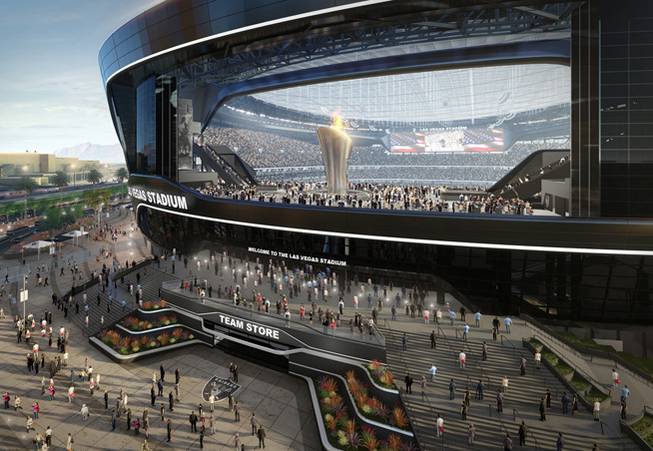
Courtesy
An artist’s rendering of the stadium being built in Las Vegas where the Raiders and UNLV will play football.
Published Tuesday, Aug. 28, 2018 | 10:24 a.m.
Updated Tuesday, Aug. 28, 2018 | 11:29 a.m.
The long-awaited Las Vegas stadium parking plan includes up to 12,275 off-site parking spaces, according to county documents.
The plan for the $1.84 billion, 65,000-seat domed stadium includes 2,375 on-site parking spaces, in addition to using four neighboring sites for a total of 14,650 spaces, according to the plan set to be discussed at the Sept. 5 county zoning commission meeting.
The four sites include: the Orleans (4,625 spaces) , a parking lot on Las Vegas Boulevard and Blue Diamond Road (up to 3,625 spots), the former Southwest Gas facility on Arville Street and Tropicana Avenue (1,175 spots) and a parking lot on Las Vegas Boulevard and Arby Avenue (2,500).
Fans who park at off-site lots will be transported to the stadium via shuttle buses, which are estimated to take 5-13 minutes, depending on the parking site.
From the Orleans, it will take 6-8 minutes each way; from Arville and Tropicana, it’s estimated at 5-7 minutes; for the Las Vegas Boulevard and Arby Avenue site, it’s 6-8 minutes; from the Las Vegas Boulevard and Blue Diamond Road site, it’s 10-13 minutes. The cost of parking on off-site lots was not disclosed.
Clark County Commissioner Steve Sisolak said the proposed parking plan is a good start, but it still falls under the required 16,250 spaces set by the county.
“It requires a little over 16,000 and no they didn’t get a variance (to not meet that),” Sisolak said. “It a good first step, they’re trying and have made some progress. This is not the final version I believe. They’ve got a little more to do, and I know they’ll get there.”
Rideshare and taxis are also expected to play a big role in the transportation plan.
“It is worth noting that the Raiders stadium is the first to be designed in the age of rideshare,” said Don Webb, chief operating officer of StadCo. in a document included with the parking plan. “Even though the plan’s parking capacity is sized as if it were not the case, we expect that the likes of Uber and Lyft will continue to steadily reduce stadium parking needs over time as patrons increasingly turn to rideshare as an alternative to driving and parking their own vehicles.”
The rideshare plans underscore the goal of having all fans off the stadium site within one hour of events ending. Pickup locations for rideshare will be located off-site to allow for eased entrance and exit by rideshare drivers.
Portions of Dean Martin Drive and Polaris Avenue are likely to be closed to general traffic during event days, allowing for dropoffs to occur on Dean Martin Drive. Dropoffs and pickups along Russell Road will be strictly prohibited.
The plan also notes that 25,000 parking spaces at businesses immediately to the west of the stadium, and structure parking of various resorts across Interstate 15 to the east, which are not included in their parking plan, are expected to be utilized by some fans, reducing demand for the team’s onsite and off-site parking spaces.
Also in the mix is the Regional Transportation Commission of Southern Nevada, as the plan outlines the use of public transit, and the entity’s park-and-ride lots will also be beneficial to the parking plan.
Related content
The Las Vegas Monorail, which is planned to stretch to Mandalay Bay, is not mentioned in the report.
The report states that Las Vegas is different from other stadium sites due to the high proportion of visitors, a thriving resort corridor, local attractions and the number of hotel rooms within proximity to the stadium. Also noted is that Raiders games in Las Vegas are expected to host more non-local fans than other NFL teams because game weekends will be an attractive draw for fans from Southern California and throughout the U.S.
Many fans, of course, will opt to park in garages at Strip properties.
“That’s a big concern of mine,” Sisolak said. “Those casinos need their own parking and I don’t want their parking infringed upon by guests who aren’t their customers. That’s something that they’ll definitely have to work through.”
Still, the high number of out of state fans will work to the resorts' advantage, Sisolak pointed out.
“You’re going to have a lot of people staying at the resorts who will be walking over there,” he said. “You’re going to come from out of town and say stay at the Mandalay Bay; it’s across the street. It will definitely get people staying there and other hotels. There will be a lot of walking than I think that there will at other stadiums.”
Compared with other NFL stadiums recently constructed, Las Vegas’ plan has more off-site parking spots in control of the team. The other cities — Atlanta, Baltimore, Cincinnati, Cleveland, Denver, Minneapolis and Seattle — don’t offer designated shuttles from off-site lots, but rather rely exclusively on public transportation like heavy or light rail and buses.
The report notes that additional off-site parking spots may be obtained in the future, based on public transportation habits. Specifics of the parking plan are still subject to county and the Nevada Department of Transportation approval.

Join the Discussion:
Check this out for a full explanation of our conversion to the LiveFyre commenting system and instructions on how to sign up for an account.
Full comments policy